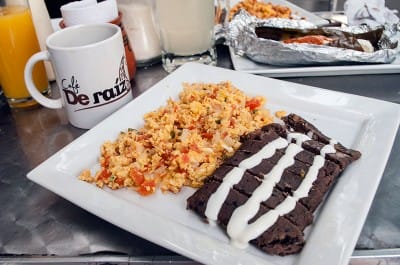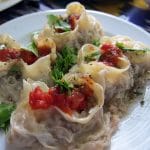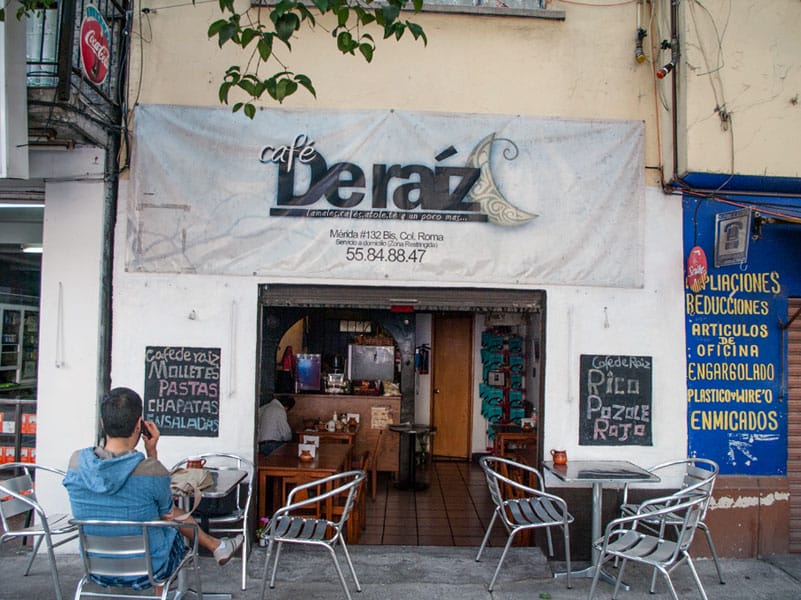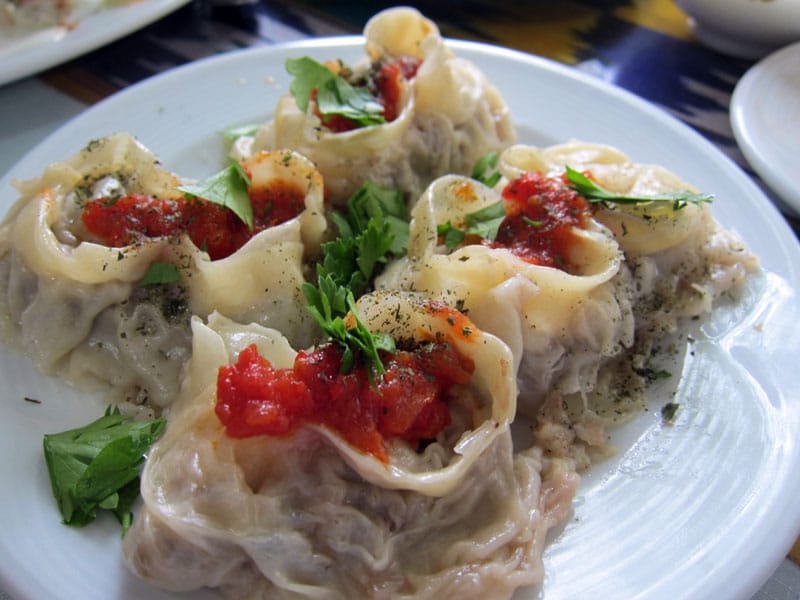The cuisine of Mexico City has long been influenced not only by waves of international immigrants but also by regional cooking from around the country. In the mid-20th century particularly, droves of workers and their families, lured by economic opportunities, arrived in the Distrito Federal from every corner of Mexico, bringing their local customs and food traditions with them and greatly enriching both the city’s culture and its culinary scene.
A coffee shop and café tucked into a small space in the hip Colonia Roma, Café de Raíz is one of those hidden jewels in Mexico City that proudly represent the cuisine of their region of the country. Owner Mardonio Carballo, a native of the eastern state of Veracruz on the Gulf of Mexico, has been preparing a simple but delicious breakfast and lunch menu from his home state for about four years. Carballo uses fresh ingredients from Veracruz for most of the food and drinks served at his establishment, starting with the coffee, which is of the highest quality. It’s a smart choice, since Veracruz is one of the main coffee-producing areas in Mexico and some of the best roasts come from the state.
Eager to taste some of the regional food from Veracruz that we had heard so much about, we started off a recent breakfast at Café de Raíz with a café americano and a concha veracruzana, a sweet roll cut in half and stuffed with refried beans and melted manchego cheese. The roll was served with a side of salsa de chile de árbol, one of the spiciest dried chilies eaten in Mexico. The combination of sweet, savory and spicy flavors is a common theme in Mexican cuisine, and it worked particularly well here with the soft and fluffy concha.
We next tried a tamal de arroz con champiñones, a rice tamal with mushrooms, made with whole grains of rice wrapped in banana leaves and foil. This type of tamal is typically known as a tamal chino, or “Chinese tamal,” in Veracruz because rice or a rice paste replaces the corn masa that is more traditionally used in tamales. Our tamal was stuffed with mushrooms and then topped with fresh cream and the same chile de árbol salsa used for the concha. It was completely different from any other tamal  we’ve tasted in the city, and it didn’t disappoint; the starchy rice worked perfectly with the beautifully seasoned mushrooms.
we’ve tasted in the city, and it didn’t disappoint; the starchy rice worked perfectly with the beautifully seasoned mushrooms.
Main dishes include the huevos huastecos, scrambled eggs cooked with sausage, chorizo, ham and/or cheese, or made in the classical a la mexicana style, with a combination of onion, tomato and a fresh green chili, usually jalapeño or serrano. We ordered one portion a la mexicana and one with a combination of egg and chorizo. Huevos huastecos is a typical dish found at almost every restaurant or stand serving breakfast, and Raíz’s versions, though very good – particularly the chorizo, which was of very high quality – were fairly standard. But what really stood out was the tamal de frijoles, or black bean tamal, that accompanied each serving of the eggs. Most tamales are steamed corn masa cakes stuffed with a little bit of salsa, meat or vegetables. Here, though, the black bean tamal seemed to have been made with an equal ratio of beans and corn masa, resulting in a dark color and a strong beany flavor. Topped with a drizzle of cream and chile de árbol salsa, the tamal was an unexpectedly delicious treat.
Café de Raíz is modest establishment, with just a couple of aluminum tables and chairs placed on the sidewalk outside and a handful of simple wooden tables inside, along with a long cushioned bench that lines one wall. The simple décor consists of a few lamps and framed pictures, while the back of the venue is taken up by a small open kitchen area where food and drinks are prepared. The venue also offers a few lunch items, including Mexican panini (chapatas), sandwiches and salads. But it’s the hearty Veracruz-style breakfast that’s going to make a lasting mark on the vibrant food scene of Mexico City.
 January 31, 2020 Adega Solar Minhoto
January 31, 2020 Adega Solar Minhoto
The clock strikes 11:55 a.m., and the tables at Adega Solar Minhoto are already filling […] Posted in Lisbon July 1, 2022 Özbek Sofrası
July 1, 2022 Özbek Sofrası
In the former Soviet Central Asian republics, the boilerplate restaurant menu consists […] Posted in Istanbul October 14, 2021 Falling for The City
October 14, 2021 Falling for The City
Update: Barba is sadly no longer open.
Fall often crashes down like a ton of bricks […] Posted in Istanbul
Published on June 27, 2013
Related stories
January 31, 2020
LisbonThe clock strikes 11:55 a.m., and the tables at Adega Solar Minhoto are already filling up with hungry customers. Many are regulars who come daily – they know that this traditional restaurant in the Alvalade neighborhood doesn’t accept bookings and is packed by midday, requiring a bit of a sprint if you don’t want to wait…
July 1, 2022
IstanbulIn the former Soviet Central Asian republics, the boilerplate restaurant menu consists of plov, lagman, shashlik and samsa. Tired-looking Uzbek, Kyrgyz, Kazakh and Tajik establishments all serve up the same limp noodles and oily rice with a shrug – it’s their job. In the markets of Samarkand, Osh and Almaty, we found some exciting exceptions…
October 14, 2021
IstanbulUpdate: Barba is sadly no longer open. Fall often crashes down like a ton of bricks over Istanbul, but it’s a welcome blow. Crisp evenings replace sticky, humid ones overnight. During the day it’s warm enough to walk around in a T-shirt if it’s sunny, though you may need to have a sweater on hand…


















































































